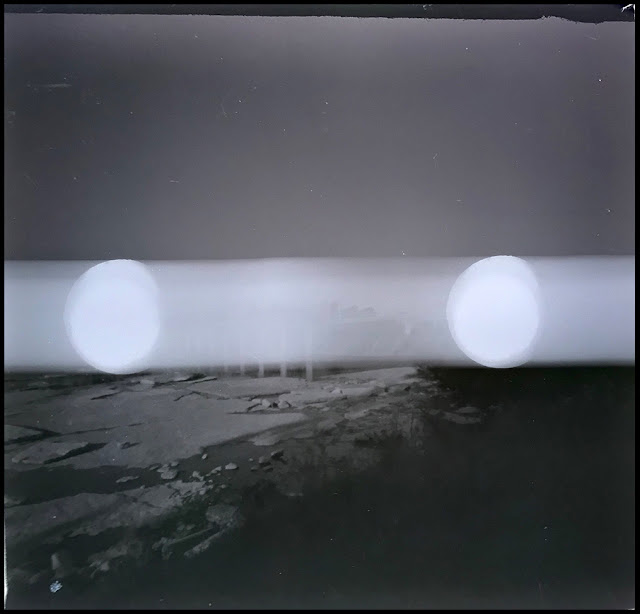In a workshop with two very gracious, enthusiastic and patient participants at the Trout Museum of Art, I experienced a series of firsts.
Joanne is a retired library assistant who had started in photography documenting library collections of objects with a 110 camera and never had used a camera that wasn't completely automatic. She now volunteers in a hospital and takes photographs which she pairs with inspirational quotes and has an agreement with a greeting card company to publish them.
John is a recently graduated engineer. He bought a Minolta SLR a few years ago and has been taking pictures with color film, but had never processed his own negatives. Ironically, Failure Analyst Engineer is his current job title. Can you see where I'm going with this?
The previous Saturday had gone well. Both made excellent cameras. I overlooked warning them about avoiding the possibly unreliable cardboard with white printing, but we made special efforts to light proof the cameras with opaque tape. They are regular 120 Populists, Joanne's is a 45mm and John's 30mm, no customization. There was no noticable issue of not being light tight, sort of.
It was notable they both drilled excellent pinholes within a couple hundredths of a millimeter of optimum, on the first try.
Next was mixing the caffenol. I had already drawn the liter of water and measured the temperature as 69 degrees F. Then, as I do everytime I mix caffenol, divided the recipe in half for a single roll of film as I read it to them to measure and mix. We developed the film in half-strength developer! Twenty-three grams of coffee (9 teaspoons) in a liter is just as opaque as the full recipe. I thought the negatives looked thin but were easily recoverable with the simple editing on the iPad. I didn't realize what I'd done until the next morning, ironically while I was weighing coffee grounds. This could be concerning for a septuagenarian. I was commiserating with someone about stage fright recently. We both observed that once the event started, it went away as you operated according to the programmed script. My brain must have copied a few lines of code and forgot to change a parameter for the new application.
But there's more. That turned out to not be the worst.
When we got the film off the reel, we discovered that John's film, beginning on the second frame, had a grey streak down the middle exactly the same width as the counter hole with the occasional circular hot spot, slightly doubled, at random spaces along the negatives. This is with a handmade pinhole camera, so when he had the counter shutter open he would have to pause to loosen the supply occasionally as he advanced to the next number.
I watched him do this after frames two and three and saw the numbers on the backing paper. He did this in the shade. The counter hole was otherwise always covered by a shutter exactly like every camera I’ve ever made. I once saw a number appear on the negative this way, but it had been left open in the direct sun for several minutes. I've also left them open in the sun and got nothing.
It’s as if he opened the counter shutter but there was no backing paper at all. But the backing paper looks perfectly normal. The negatives look like the film was flat against the image plane, ergo not separated from the backing paper.
This was with a 120 roll of Ilford FP4+ which I watched him take out of the box and foil, load into the camera and advance to the first frame.
The streak did not appear in the first frame. There's what looks like a legitimate light leak in the bottom i.e. the top of the camera. This is with a 90° angle of view camera and I think it just might be some sunlit ornamental grasses in a planter he didn't imagine moved this much during the exposure. In any event, it doesn't show up in any of the other exposures.
The hotspots were kind of at random, consistent with the idea that he paused occasionally while winding the film. Some of these look tilted but that's just the negative being slightly tilted under the iPad camera used to capture the file. The streak is perfectly straight from it's beginning to the end of the film
Could this be a manufacturing flaw? I’ve heard complaints in the past but I can’t imagine how it would happen. I had a rough streak down the middle of a couple of frames once with a roll of FP4+ and later found a slit down the middle of the backing paper. But this one looks fine.
Here's the backing paper of the suspect roll held against my iphone flashlight, my normal test of opacity. I can't see a hint of translucence.
For comparison, here is the backing paper from the other participant, again with the iPhone flashlight held against it. Those negatives looked completely normal except for the under-development.
The inside of the camera looks well constructed and seems adequately light tight from looking at the un-streaked parts of the negative.














No comments:
Post a Comment